112/7/D2
Search This Category
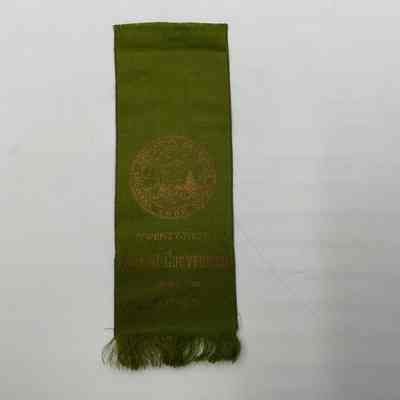
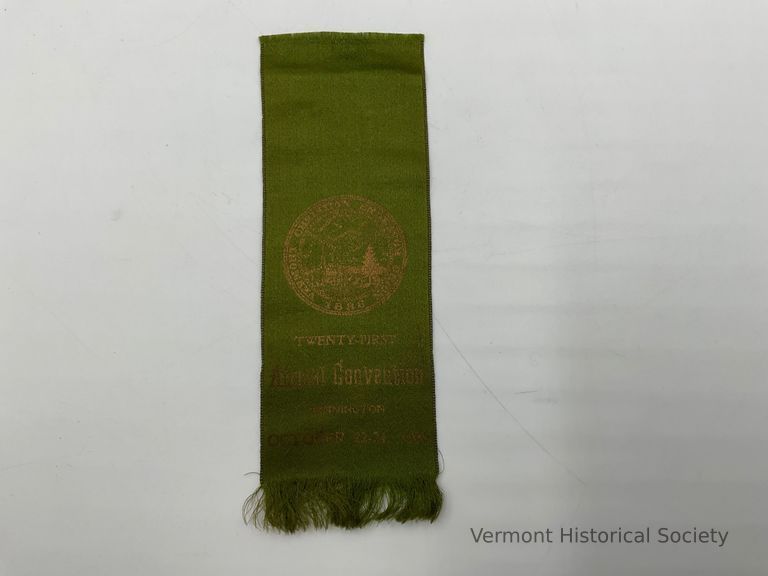
Badge
Name/Title
Badge
Lexicon
Description
Olive green ribbon with a faded gold seal of the Christian Endeavor Society in the center and underneath the words "Twenty-first Annual Convention, Bennington, October 22-24, 1906."
Acquisition
Accession
1999.36
Relationships
Related Person or Organization
Christian Endeavor Society
Person or Organization
Related Places
Place
Bennington
City
Bennington County
County
Vermont
State/Province
United States of America
Country
North America
Dimensions
Materials
Material
Synthetic
Entry/Object ID
1999.36.3
Context
(From Encyclopedia Britannica)
"The Society of Christian Endeavor was founded in 1881 by Francis Edward Clark in Maine. He served as president until 1927. Members of the society pledged to try to make some useful contribution to the life of the church. Other churches soon organized Christian Endeavor societies, and the movement grew rapidly in the United States.
Francis Edward Clark, (born Sept. 12, 1851, Aylmer, Quebec, Can.—died May 26, 1927, Newton, Mass., U.S.), Congregational churchman and writer who founded and led Christian Endeavor.
Clark graduated from Dartmouth College in 1873 and Andover Theological Seminary in 1876. He was pastor of churches in Portland, Maine (1876–83), and South Boston (1883–87). In 1881 he founded the United Society of Christian Endeavor, an autonomous interdenominational organization of young people. Its members pledged to lead a Christian life, to pray to God and read the Bible every day, and to participate actively in the work of the church. In 1887 he resigned his pastorate to serve as the organization’s president.
Clark became president of the World Christian Endeavor Union in 1895 and traveled around the world five times in the interests of its work. Clark also edited The Christian Endeavor World (1887–1919) and wrote many books on religious themes for young people."
"The Society of Christian Endeavor was founded in 1881 by Francis Edward Clark in Maine. He served as president until 1927. Members of the society pledged to try to make some useful contribution to the life of the church. Other churches soon organized Christian Endeavor societies, and the movement grew rapidly in the United States.
Francis Edward Clark, (born Sept. 12, 1851, Aylmer, Quebec, Can.—died May 26, 1927, Newton, Mass., U.S.), Congregational churchman and writer who founded and led Christian Endeavor.
Clark graduated from Dartmouth College in 1873 and Andover Theological Seminary in 1876. He was pastor of churches in Portland, Maine (1876–83), and South Boston (1883–87). In 1881 he founded the United Society of Christian Endeavor, an autonomous interdenominational organization of young people. Its members pledged to lead a Christian life, to pray to God and read the Bible every day, and to participate actively in the work of the church. In 1887 he resigned his pastorate to serve as the organization’s president.
Clark became president of the World Christian Endeavor Union in 1895 and traveled around the world five times in the interests of its work. Clark also edited The Christian Endeavor World (1887–1919) and wrote many books on religious themes for young people."
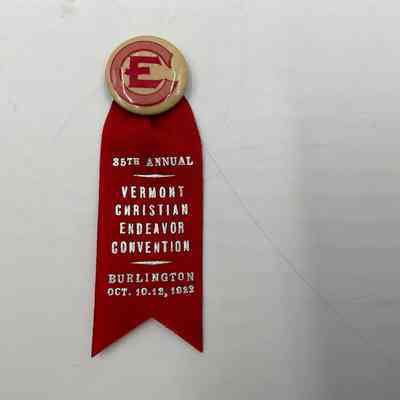
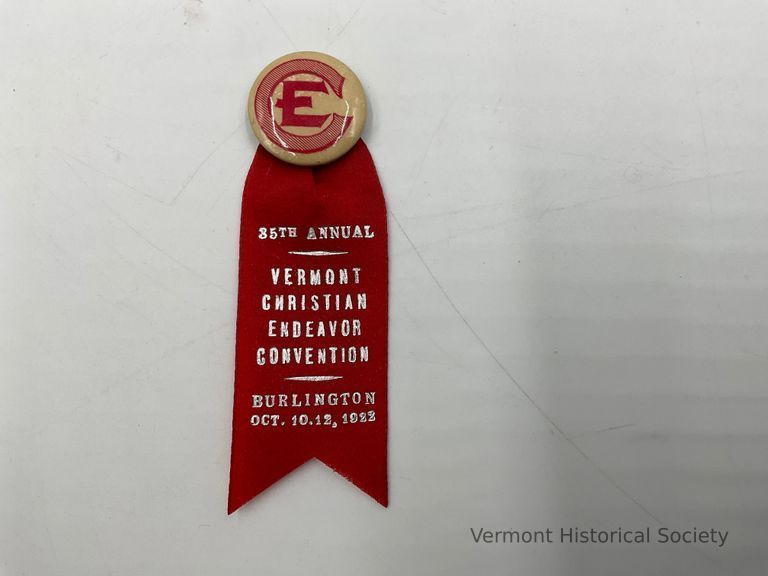
Badge
Name/Title
Badge
Lexicon
Description
White button with the logo for the Society of Christian Endeavor -- an E within a C -- printed in red and an attached red ribbon. Printed in silver on the ribbon is: "35th annual Vermont Christian Endeavor Convention, Burlington, Oct. 10-12, 1922.
Acquisition
Accession
1999.36
Relationships
Related Person or Organization
Christian Endeavor Society
Person or Organization
Related Places
Place
Burlington
City
Chittenden County
County
Vermont
State/Province
United States of America
Country
North America
Dimensions
Materials
Material
Synthetic, Metal
Entry/Object ID
1999.36.12
Context
(From Encyclopedia Britannica)
"The Society of Christian Endeavor was founded in 1881 by Francis Edward Clark in Maine. He served as president until 1927. Members of the society pledged to try to make some useful contribution to the life of the church. Other churches soon organized Christian Endeavor societies, and the movement grew rapidly in the United States.
Francis Edward Clark, (born Sept. 12, 1851, Aylmer, Quebec, Can.—died May 26, 1927, Newton, Mass., U.S.), Congregational churchman and writer who founded and led Christian Endeavor.
Clark graduated from Dartmouth College in 1873 and Andover Theological Seminary in 1876. He was pastor of churches in Portland, Maine (1876–83), and South Boston (1883–87). In 1881 he founded the United Society of Christian Endeavor, an autonomous interdenominational organization of young people. Its members pledged to lead a Christian life, to pray to God and read the Bible every day, and to participate actively in the work of the church. In 1887 he resigned his pastorate to serve as the organization’s president.
Clark became president of the World Christian Endeavor Union in 1895 and traveled around the world five times in the interests of its work. Clark also edited The Christian Endeavor World (1887–1919) and wrote many books on religious themes for young people."
"The Society of Christian Endeavor was founded in 1881 by Francis Edward Clark in Maine. He served as president until 1927. Members of the society pledged to try to make some useful contribution to the life of the church. Other churches soon organized Christian Endeavor societies, and the movement grew rapidly in the United States.
Francis Edward Clark, (born Sept. 12, 1851, Aylmer, Quebec, Can.—died May 26, 1927, Newton, Mass., U.S.), Congregational churchman and writer who founded and led Christian Endeavor.
Clark graduated from Dartmouth College in 1873 and Andover Theological Seminary in 1876. He was pastor of churches in Portland, Maine (1876–83), and South Boston (1883–87). In 1881 he founded the United Society of Christian Endeavor, an autonomous interdenominational organization of young people. Its members pledged to lead a Christian life, to pray to God and read the Bible every day, and to participate actively in the work of the church. In 1887 he resigned his pastorate to serve as the organization’s president.
Clark became president of the World Christian Endeavor Union in 1895 and traveled around the world five times in the interests of its work. Clark also edited The Christian Endeavor World (1887–1919) and wrote many books on religious themes for young people."
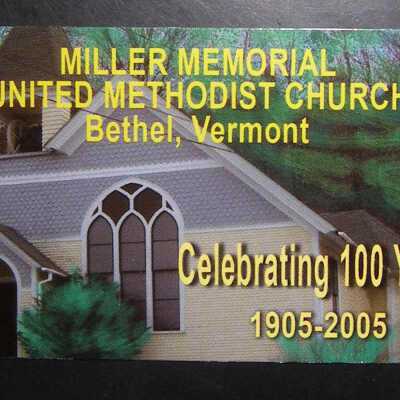

Magnet
Name/Title
Magnet
Lexicon
Description
Rectangular magnet with "MILLER MEMORIAL/ UNITED METHODIST CHURCH / Bethel, Vermont / Celebrating 100 Years / 1905 - 2005" The yellow writing is superimposed over a photograph of the church.
Acquisition
Accession
2005.44
Relationships
Related Places
Place
Bethel
Town
Windsor County
County
Vermont
State/Province
United States of America
Country
North America
Made/Created
Date made
2005-2005
Manufacturer
Miller Memorial United Methodist Church
Dimensions
Materials
Material
Plastic, Magnet
Entry/Object ID
2005.44
Context
This church was built in 1905. Here is a bit of Bethel history that notes the construction of new churches.
(Source: https://townofbethelvt.com/index.asp?SEC=521041EA-7D21-4547-B4DE-F502747A9E43)
"Bethel Village sustained its "Golden Age" from the late 1880’s until the early 1920’s and developed an industrial character. The three largest industries of the era—the shoe shop, the tannery and the white granite quarry and cutting sheds—flourished because of the ease of railroad transportation, the availability of local workers and the influx of European immigrants skilled in granite extraction, cutting and sculpting. During this period Bethel proudly enhanced its community with major cultural and civic improvements including the town hall, the first high school and library, electric lighting, new churches, and civic and business organizations. Main street businesses thrived as they supported the many needs of the community. By 1910, the town population grew to 1,953 with nearly 50% of the citizens residing in the Village."
(Source: https://townofbethelvt.com/index.asp?SEC=521041EA-7D21-4547-B4DE-F502747A9E43)
"Bethel Village sustained its "Golden Age" from the late 1880’s until the early 1920’s and developed an industrial character. The three largest industries of the era—the shoe shop, the tannery and the white granite quarry and cutting sheds—flourished because of the ease of railroad transportation, the availability of local workers and the influx of European immigrants skilled in granite extraction, cutting and sculpting. During this period Bethel proudly enhanced its community with major cultural and civic improvements including the town hall, the first high school and library, electric lighting, new churches, and civic and business organizations. Main street businesses thrived as they supported the many needs of the community. By 1910, the town population grew to 1,953 with nearly 50% of the citizens residing in the Village."
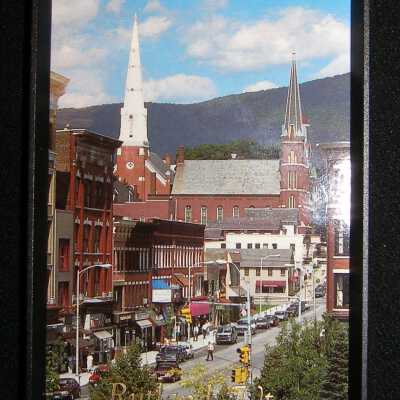
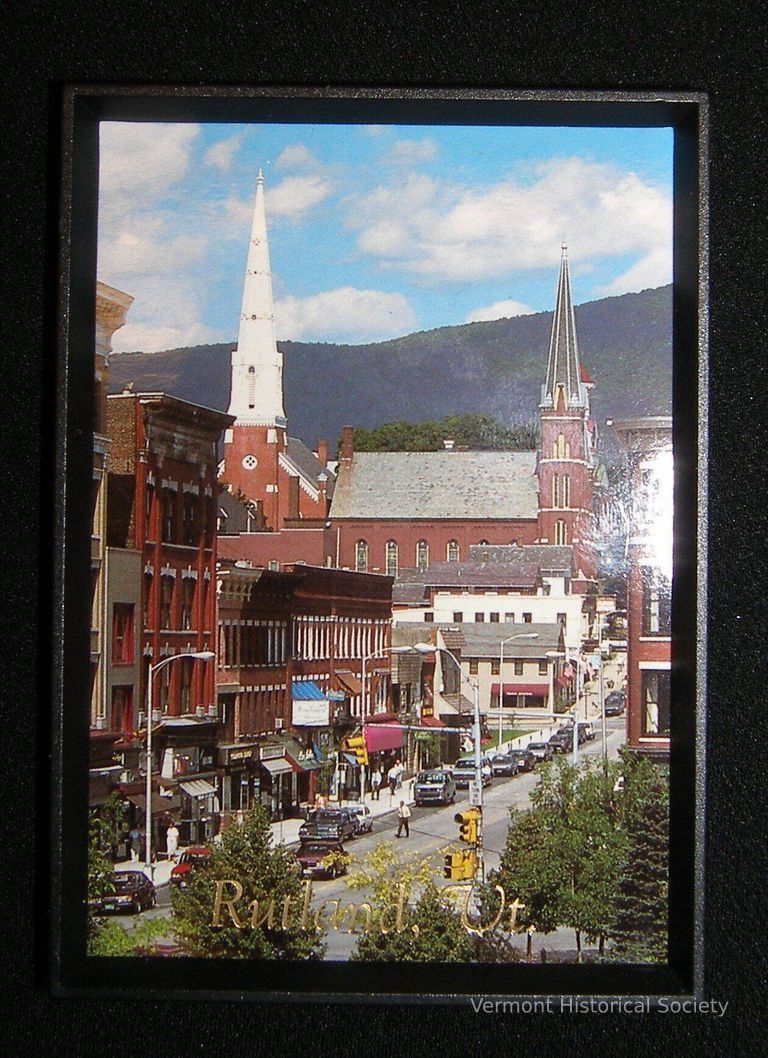
Magnet
Name/Title
Magnet
Lexicon
Description
Photographic magnet showing a city street lined with shops. Two church steeples are in the background, and the who is in front of a large mountain. The bottom of the image is labeled, "Rutland, Vt." in gold. The back of the magnet bears the inscription, "SCENIC VERMONT / Eastern Illustrating Union, Maine Made in USA".
Acquisition
Accession
2000.55
Relationships
Related Places
Place
Rutland
City
Rutland County
County
Vermont
State/Province
United States of America
Country
North America
Made/Created
Manufacturer
Eastern Illustrating
Dimensions
Dimension Description
Overall
Materials
Material
Magnet, Paperboard
Entry/Object ID
2000.55.4
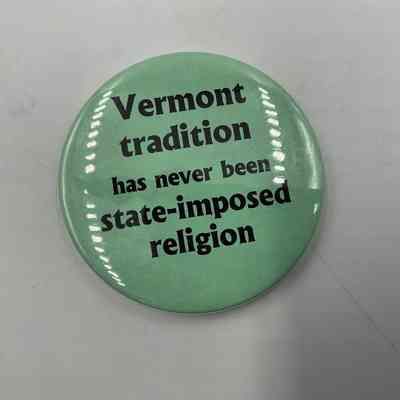
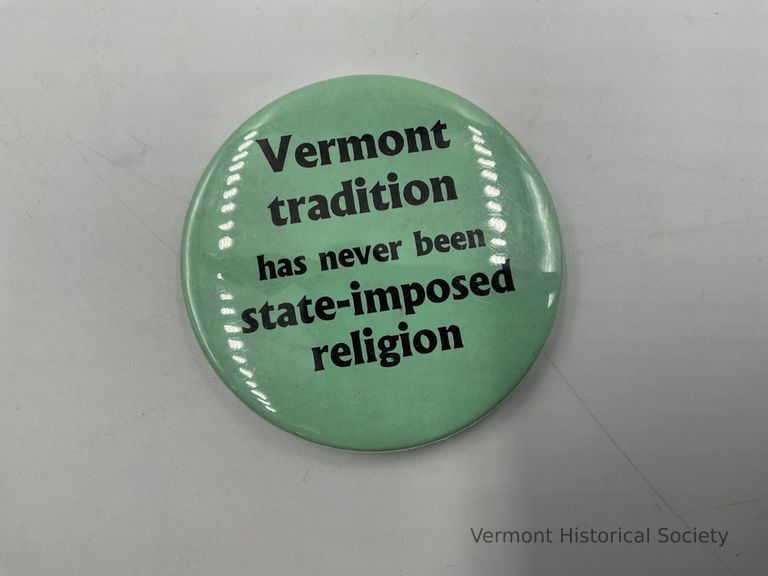
Magnet
Name/Title
Magnet
Lexicon
Description
A pale green magnet with black lettering that says, "Vermont Tradition has never been state-imposed religion."
Acquisition
Accession
2019.20
Made/Created
Manufacturer
Badge-a-Minit
Dimensions
Materials
Material
Metal, Magnet
Entry/Object ID
2019.20.7
Context
No information found to explain the purpose/context for this magnet.
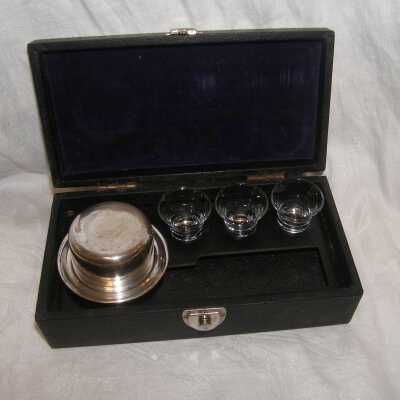
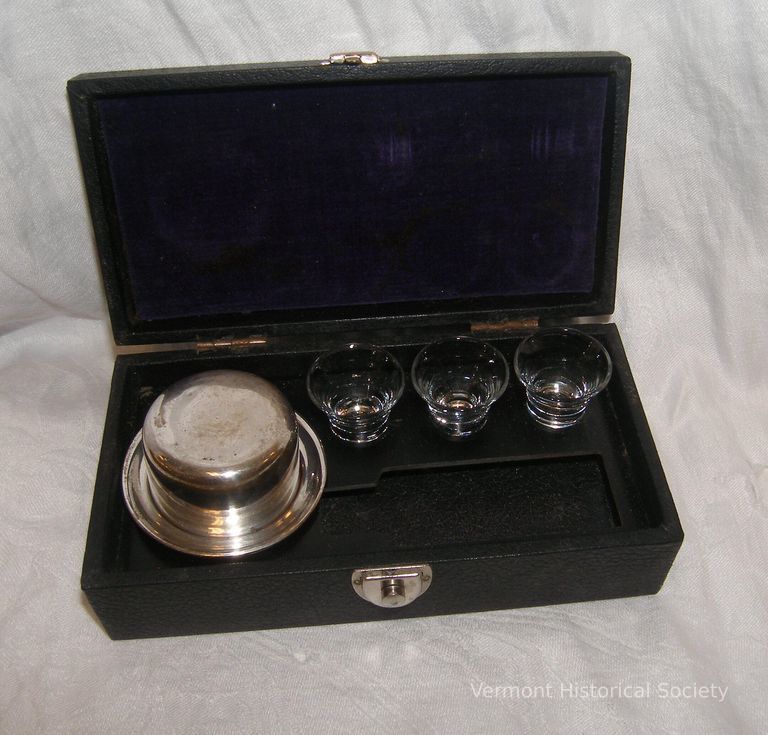
Set, Communion
Name/Title
Set, Communion
Lexicon
Description
a= Black leatherette-covered box with attached cover lined in purple velvet. Bottom of box has metal piece with cutouts to hold (b) round covered container to hold the "host", (c) - (e) 3 wine glasses, and space for a bottle for wine (bottle missing). Also in box is a string of 21 military buttons of different sizes and types (f).
Acquisition
Accession
2016.11
Relationships
Related Events
World War II
Event
Made/Created
Date made
1942-1945
Dimensions
Materials
Material
Wood, Metal, Artificial Leather, Glass, Silverplate, Brass
Entry/Object ID
2016.11.70a-e
Context
Notes: http://cdi.uvm.edu/findingaids/collection/hewitt.ead.xml
Arthur W. Hewitt was born in Riverton, Vermont, June 22, 1883. He attended Riverton schools and was a graduate of Northfield High School and Montpelier Seminary. On September 18, 1907 he married Nina Battles of Wilder.
Dr. Hewitt's pastoral life began in 1908 in Plainfield, Vermont, where he served as a minister of the Methodist Church until 1933. He served in Moretown, Vermont from 1933-35, and in Northfield and Northfield Falls until 1956.
Dr. Hewitt was also active in education. He was superintendent of schools in Glover, 1905-1906, and in Plainfield, 1910-1911. He was, for a time, the head of Montpelier Seminary, organized Vermont Junior College, and served as its president from 1923 to 1935. During the years 1912-1917, as Plainfield's representative in the Vermont General Assembly, he was chairman of the House Committee on Education. From 1923 to 1935 he was chairman of the Vermont Board of Education.
Hewitt was also a poet. He published five collections of poetry, including, Harp of the North (1916) and The Mountain Troubador (1962.) He also wrote a biography entitled The Old Brick Manse (1965). he was the head of the Poetry Society of Vermont (P.S.O.V.) for eight years, and in August of 1971 he was recommended by the state legislature to succeed Robert Frost as Poet Laureate of Vermont. He died November 6, 1971 in Berlin, Vermont.
Concerning the military buttons, it isn't clear if these belonged to Arthur Wentworth Hewitt. While he registered for the draft for World War I at age 35 and for WWII at age 58, there is no mention of military service in any obituaries or biographies.
Arthur W. Hewitt was born in Riverton, Vermont, June 22, 1883. He attended Riverton schools and was a graduate of Northfield High School and Montpelier Seminary. On September 18, 1907 he married Nina Battles of Wilder.
Dr. Hewitt's pastoral life began in 1908 in Plainfield, Vermont, where he served as a minister of the Methodist Church until 1933. He served in Moretown, Vermont from 1933-35, and in Northfield and Northfield Falls until 1956.
Dr. Hewitt was also active in education. He was superintendent of schools in Glover, 1905-1906, and in Plainfield, 1910-1911. He was, for a time, the head of Montpelier Seminary, organized Vermont Junior College, and served as its president from 1923 to 1935. During the years 1912-1917, as Plainfield's representative in the Vermont General Assembly, he was chairman of the House Committee on Education. From 1923 to 1935 he was chairman of the Vermont Board of Education.
Hewitt was also a poet. He published five collections of poetry, including, Harp of the North (1916) and The Mountain Troubador (1962.) He also wrote a biography entitled The Old Brick Manse (1965). he was the head of the Poetry Society of Vermont (P.S.O.V.) for eight years, and in August of 1971 he was recommended by the state legislature to succeed Robert Frost as Poet Laureate of Vermont. He died November 6, 1971 in Berlin, Vermont.
Concerning the military buttons, it isn't clear if these belonged to Arthur Wentworth Hewitt. While he registered for the draft for World War I at age 35 and for WWII at age 58, there is no mention of military service in any obituaries or biographies.
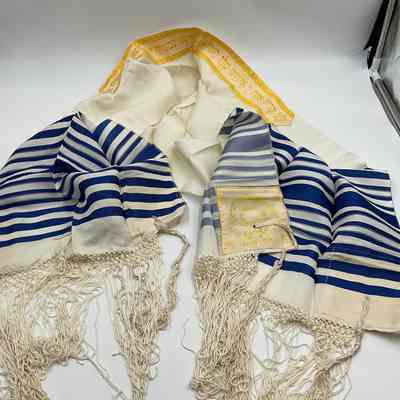
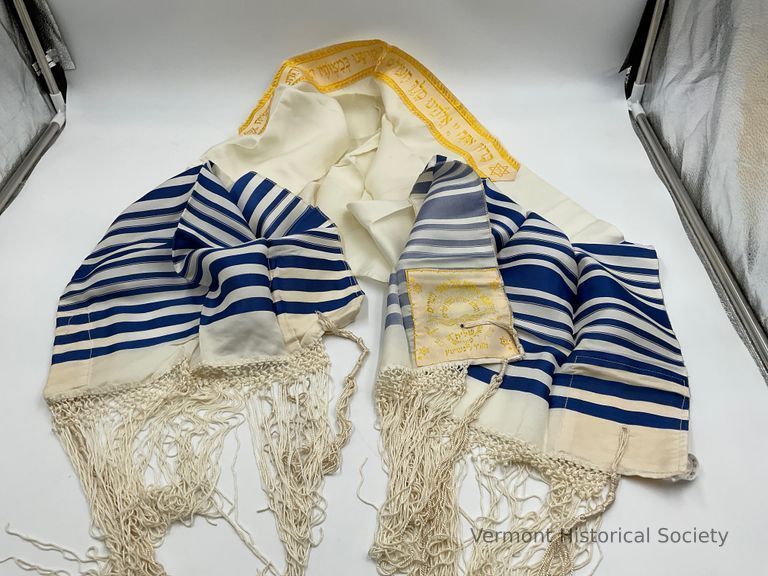
Tallit
Name/Title
Tallit
Lexicon
Description
A blue and white silk tallit, or prayer shawl for Jewish services, with long white tassels at each end and decorative band of gold and white on one edge with Hebrew writing.
Accompanied by a plush maroon velvet zippered case, 2008.22.13b.
Accompanied by a plush maroon velvet zippered case, 2008.22.13b.
Use
Used in Jewish services at the Ira Allen Chapel at the University of Vermont prior to 1980. Given to Lilian Baker Carlisle in 1980 by David Blow who was the archivist at the University of Vermont.
Acquisition
Accession
2008.22
Ethnography
Relationships
Related Person or Organization
David Blow
University of Vermont
Made/Created
Manufacturer
Rabbi M. Lipschitz
Dimensions
Dimension Description
Dimensions for the woven part of the shawl, excluding the fringe.
Materials
Material
Silk
Entry/Object ID
2008.22.13a
Context
From Encyclopedia Britannica,
"A ?allit, also spelled ?alit, tallis, or tallith, plural ?allithim, ?alithim, tallithim, or tallisim, prayer shawl worn by male Jews during the daily morning service (sha?arit); it is also worn by the leader of the service during the afternoon service (min?a). On Yom Kippur, males wear it for all five services and on Tisha be-Av only during the afternoon service.
Rectangular in shape, the wool (or sometimes silk) shawl has black or blue stripes with fringes (tzitzit) affixed to the four corners as the Bible prescribes (Numbers 15:38). Two fringes fall in front, two behind. Often an embroidered collar is added, inscribed with the blessing to be recited when the ?allit is put on. A pious Jew is often buried in his ?allit after one of the fringes has been removed."
"A ?allit, also spelled ?alit, tallis, or tallith, plural ?allithim, ?alithim, tallithim, or tallisim, prayer shawl worn by male Jews during the daily morning service (sha?arit); it is also worn by the leader of the service during the afternoon service (min?a). On Yom Kippur, males wear it for all five services and on Tisha be-Av only during the afternoon service.
Rectangular in shape, the wool (or sometimes silk) shawl has black or blue stripes with fringes (tzitzit) affixed to the four corners as the Bible prescribes (Numbers 15:38). Two fringes fall in front, two behind. Often an embroidered collar is added, inscribed with the blessing to be recited when the ?allit is put on. A pious Jew is often buried in his ?allit after one of the fringes has been removed."